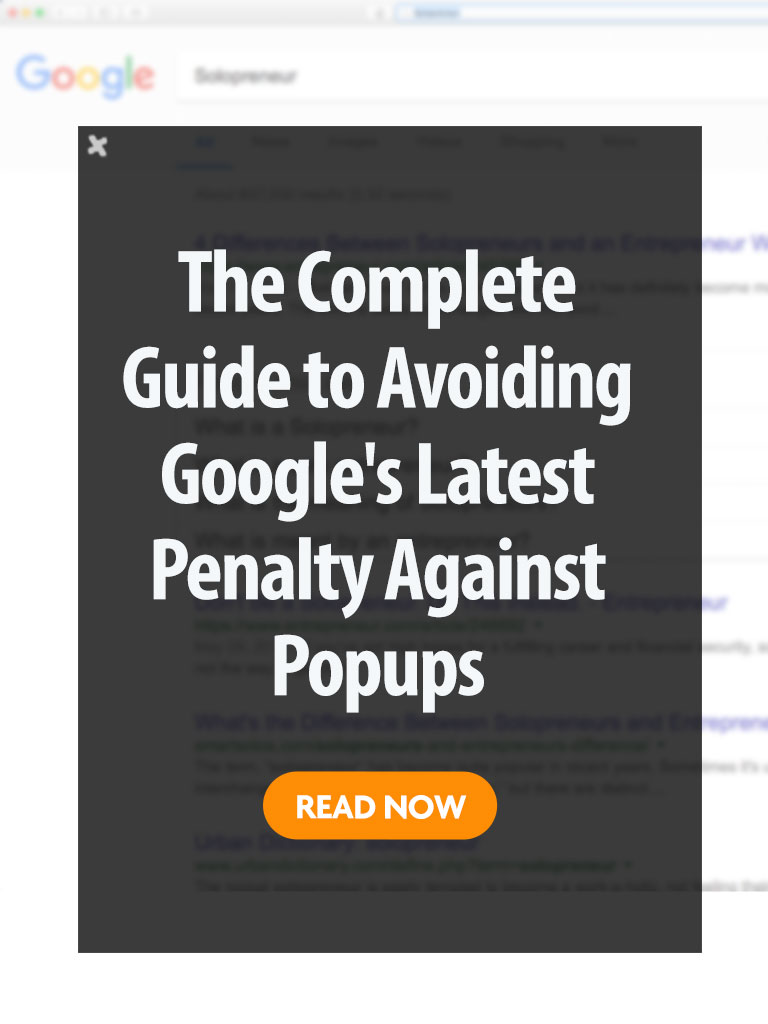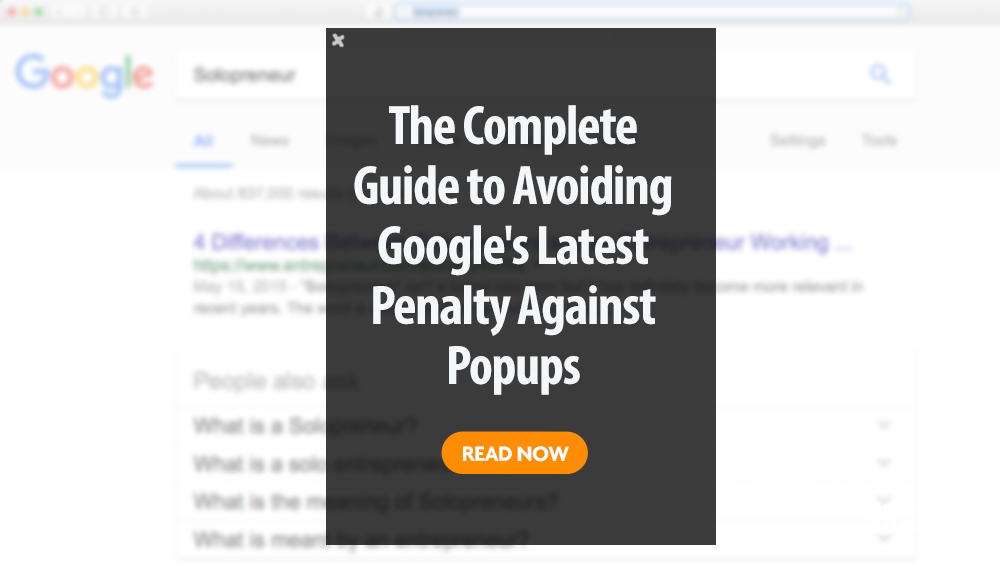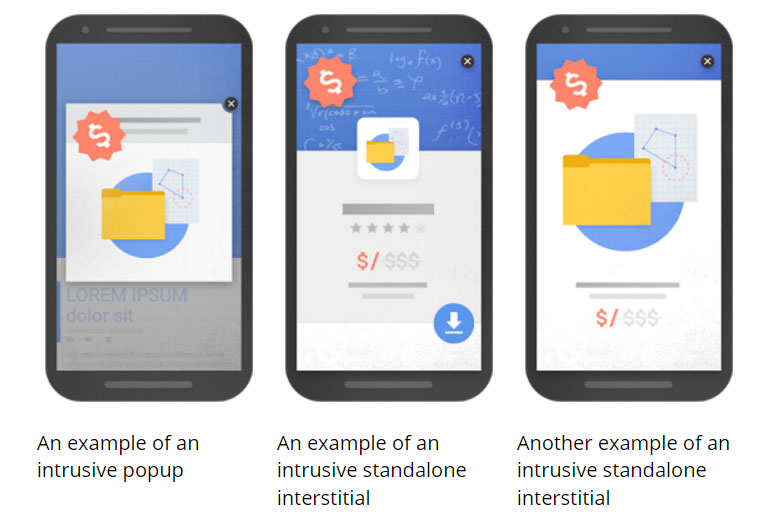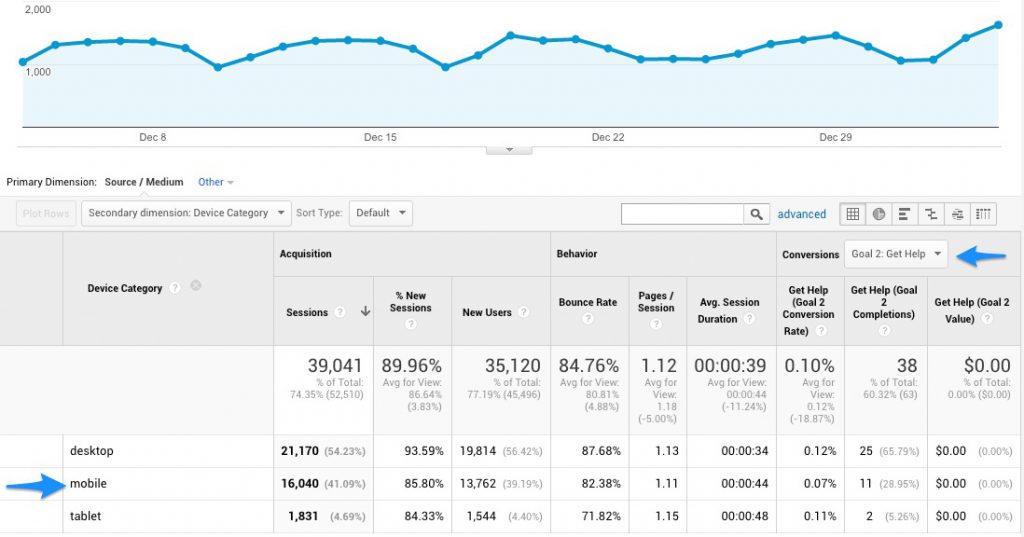In February 2015, Google shocked the blogosphere by announcing that sites that failed to provide mobile-friendly experiences to mobile users would see their sites penalized in mobile search. (For more background, see our “Mobile Readiness” article.)
It didn’t turn out to be the “Mobilegeddon” that everyone feared at the time. Think about it…
Each factor change (or addition) can really only ever attain more than “lightweight” status when a significant majority of sites adopts Google’s recommendation.
Otherwise, Google would damage the quality of its SERPs if it weighted a little-adopted factor (for example, AMP) so highly that it pushed down the pages with the best quality, relevance, originality, etc. just because these pages did not use that factor.
Even before their landmark entry into mobile, it was obvious that Google would soon address mobile-specific problems. They would, logically, want the best experience for the rapidly growing numbers of mobile users of Google Search (user satisfaction = more searches = more revenue from ad buyers).
Google’s first significant dive into the mobile arena came late. Many sites were building duplicate versions of their sites specifically for mobile (e.g., m.example.com).
Other options abounded, targeted at making it easy for solopreneurs to be mobile-friendly (they weren’t, and they often backfired). That entire debate stopped when Google announced that “responsive design” was their preferred option.
So, when it came to the mobile options for their websites and online businesses, we waited until the dust cleared. We are “fast-followers,” which means that SBIers do not have to “revolve” (i.e., scrap a ton of work and start all over again. Solopreneurs don’t have the time).
From responsive themes to assistive tools, SiteSell has advocated a mobile-friendly approach, enabling SBIers to optimize their visitors’ mobile experience. The SBI! Process, C T P M, evolves as the Internet does.
More recently, Google has looked at fast page loads (page speed) and even introduced a new markup (AMP) for websites. With AMP, Google’s aim has been, and is, to serve (from Google servers) to mobile visitors “bare-bones” versions of sites that load extremely fast.
More importantly, as of the time of this writing, the adoption rate is not nearly high enough for Google to make AMP a significant factor in its algorithm. This may turn out to be another failed “extortion through Google algo,” especially because there is a finite time window here — the medium-term future is that there will be high enough mobile bandwidth for AMP to stop being an important concern. So we opt to watch and wait. We can develop the internal tools for SBIers, and handle the tech stuff. But it’s still a ton of work for our solopreneur clients. Some of the risks include loss of traffic along with loss of time if AMP is abandoned. Bottom line: We understand and agree with much of what Google does. They have, though, been known to extort some changes by promoting them as new factors. WIN-WINs (such as XML sitemaps) were quick winners. But many have failed (even the relatively simple-to-do Google Authorship, which was seen by many as “the future”). In the same way that we act in the best interests of SBIers, not Google, you too must decide upon the optimal use of your time. But we digress….

Now, Google is targeting interstitials — otherwise known as “popups”…
Announced months ago, it comes into effect on January 10. Since most folks leave matters like this to the last second, here’s your timely “do something” reminder.
It only applies to you if you’re using interstitials or other ways to obscure the mobile reader’s view of the content s/he expected to see right away, with no hurdles to overcome!
In this article, we take a look at what an “interstitial” is (and what it is not). We clarify Google’s plan. And then, most importantly, we will guide you through what all this means for you. By the end of this article, you’ll know exactly what to do (or not do!).
Without further ado…
What Are Interstitials?
“Interstitial” is a medical term referring to tissue between the cells of a structure or part.

Hey, it’s never too late to learn something new!
Google’s definition hijacks the medical “interstitial” to mean…
Any web element that is placed between the mobile user’s search results and the resulting content.
Let’s “real-world” this…
Google’s SERP tells its users that “Page A is your best choice.” The problem is that, when they click Google’s link, they don’t get the content!
If users encounter an element that leaves no option but to deal with it before they can continue to the content they selected from the search results, it’s an “interstitial.” That includes a “welcome mat,” those full-page screens that force you to click an arrow to go down to the “real content.”
Google, understandably, isn’t thrilled by this subpar experience. Remember Google’s POV for the rest of this article. Although there have been many complaints about this, it just want the best experience for its users.

Gee, thanks Google. Those who complain forget that we marketers are not their customers (until we buy ads!). It doesn’t exist to make a marketer’s life easy. The quality of search is about searchers.
Sure, an interstitial usually leads to a highly desired response, a product purchase perhaps, or a newsletter signup. It has also been used to deliver app download opportunities, make announcements, present legal warnings, logins, etc.
So while this change causes us pain, it’s not Google’s fault. No one is pushing us around. We have to adapt. And that’s what we’ll do! Let’s get started on that…
What Is Not An Interstitial?
It’s just as important to understand what’s “not a bad boy”…
- Pop-unders aren’t. They only show when the browser window is closed.
- Exit-popups (appearing as you start to leave a site), are not considered interstitials by Google.
- Popups that take very little space and that do not gray out all the content (e.g., a chat invite in the lower right corner).
- Rare issues, such as a legal requirement to make a particular announcement, would also receive a pass by Google.
If you’re using an interstitial, you can already see some potential solutions in the first 3 examples. We have more coming!
What Exactly Is Google’s Update?
The essence of Google’s algorithm update says that sites failing to adhere to Google’s standards “might not rank as high.”
Specifically, Doantam Phan, Product Manager at Google, said…
To improve the mobile search experience, after January 10, 2017, pages where content is not easily accessible to a user on the transition from the mobile search results may not rank as highly.
It’s the “not easily accessible” part that we have to pay attention to.
Google is not saying that all interstitials are bad, or threatening to kill your search rankings if you use any of them.
Rather, they’re attempting to weed out the bad offenders — sites that use full screen popups or welcome mats, for instance. To be on the safe side, we’d include any interstitial, even a teeny one, to be “bad” if it grayed out the content (i.e., made it inaccessible), forcing a user to do something before seeing what s/he expected to see immediately.
 And truth be told, Google is in the right. Full screen interstitials are annoying enough for laptop/desktop users.
And truth be told, Google is in the right. Full screen interstitials are annoying enough for laptop/desktop users.
For mobile, it’s a horrendous experience. While some marketers and industry pundits feel that Google is once again being heavy-handed with their power, it’s fully justified if you consider the nature of Google’s business.
Phan went on to illustrate three specific kinds of interstitials that Google’s algorithm would be looking for:
- Showing a popup that covers the main content, either immediately after users navigate to a page from the search results, or while they are looking through the page.
- Displaying a standalone interstitial that the user has to dismiss before accessing the main content.
- Using a layout where the above-the-fold portion of the page appears similar to a standalone interstitial, but the “real content” has been added below the fold.
Examples of interstitials that make content less accessible
So full page interstitials, and ads that take up most of the page, are a problem. And if you put any ad “above the fold” (and even “above the page itself”) that has to be dismissed or swiped past to get to the real content (the “welcome mat”), that counts too.
Note though that smaller ads and interstitials for specific, legitimate purposes are perfectly fine. Such purposes could include…
- interstitials that appear to be in response to a legal obligation, such as for cookie usage or age verification.
- login dialogs on sites where content is not publicly indexable. This would include, for example, private content such as email, or content that is behind a paywall.
- banners that use a reasonable amount of screen space and are easily dismissible. For example, the app install banners provided by Safari and Chrome are examples of banners that use a reasonable amount of screen space.
“Reasonable” appears to be approximately 25% or less of the available screen space. The final bullet item provides another possible solution. We’re almost there!
How Badly Could This Hurt?
It’s not clear how much weighting this mobile algorithm factor will receive (it never is, of course). That said, the weighting is likely to be minor, per Google itself…
The intent of the search query is still a very strong signal, so a page may still rank highly if it has great, relevant content.
And…
This new signal is just one of hundreds of signals that are used in ranking. The intent of the search query is still a very strong signal, so a page may still rank highly if it has great, relevant content.

We mentioned above that a factor such as this requires a fair level of adoption before it would have any meaningful impact. We expect this to happen since it’s easy enough to change.
We suggest that you make an acceptable change. There are, though, exceptions. That leads us into the most important part of this article…
What Should I Do?
You now know enough to formulate your optimal response.
If you’re not currently running any kind of popup ad that’s visible to mobile readers, you have nothing to worry about, nothing to do.
Many marketers already run interstitials that are disabled when a smaller device is detected. They are, after all, particularly annoying on tiny screens.
If you’re running them on all devices, we have an easy solution to start you off…
Option One. Set your interstitials to display for desktop users only.
Yes, you’ll lose whatever you were gaining from mobile users. But you also stop annoying those folks, and your risk of losing any Google-forced traffic drops to zero. This is the most conservative option.
Option Two is just as easy. The difference is that you get to keep some or perhaps even all of what the interstitial delivers. It’s obvious. Use one of the formats that Google does not consider an interstitial (see above)…
- Pop-unders
- Exit-popups (appearing as you start to leave a site)
- Popups that take little space and that do not gray out all the content (e.g., an ad that only takes up the lower 10th of a mobile screen).
OK, moving on…
Some sites may get significant levels of traffic from mobile users. If those sites want to use an interstitial to better leverage that traffic, there are more aggressive alternatives than “hiding” (which is what we’ve been doing so far).
Instead of an interstitial, one effective approach is to use a Hello Bar. We recently released an article that outlines 5 different ways to use a Hello Bar. This technique creates a relatively small banner across the mobile viewscreen — and Google is completely OK with that.
So that’s Option Three. Use a Hello Bar to greet your mobile visitors.
It does not “pop” — it’s static, a part of your page. The user even has the option to gain back the space by clicking it, but it’s not big enough to obscure the main content.
“What’s My Most Aggressive Direction?”
Great question! Answer…
Option Four: Do The Math!
Finally, you could do nothing. Just leave your “offending” interstitials up for mobile users. Let cold-blooded math drive this decision, though — don’t gamble.
Every online business owner needs to decide for herself what the impact will be as a result of any action — or non-action. In this case, you must figure the bottom line to income, not traffic from Google.
Let’s say that your interstitial drives sales or newsletter signups (e.g., 20% more when they are there). Would a 5% loss in search traffic be more palatable than a total loss of interstitial-driven actions? And does Google Search account for 5% of your mobile traffic or 95%?
Here’s the “Thumbnail Math”…
If an AB-split test has indeed shown that you get 20% more sales with the interstitial (use of an interstitial should be supported by such a test), and if Google only accounts for 10% of all mobile traffic, it’s a no-brainer. Keep the interstitial.
The worst that could happen is that Google drops you totally (which is impossible). It’s “only” 10% of mobile traffic, while the remaining 90% of your mobile traffic is generating 20% more sales. That’s a net of 8% more sales, even in total disaster scenario!
So…
If you know the AB-split numbers and what % of traffic comes from Google, a little thumbnail math should point to a clear direction. It won’t often be so clear-cut, though. It would be nice to know the actual search-results impact of leaving your interstitials up…
Here’s how to know and use that extra data. It’s a more exact version of this option. First, make the change to a safer option. Here’s how to determine if it should be a permanent change…
- Monitor the Web for outrage. If there has been a hard hit, you’ll see it. You’ll also know you were wise to change — you can study this in a bubble of calmness. You might decide on this alone to play it safe. But if the reaction is mild to mixed…
- Test the impact on 2-3 high-ranking, but not high-traffic, pages by putting the interstitial back up for them. If they lose their ranking completely, assume the same for all pages. If you drop by 2, 3, 4, or 5 spots, estimate the loss (there are loads of studies on this).
Ideally, the reaction on the blogosphere matches your test results. Now that you know how much it’s going to hurt your Google-referred traffic, you can do the “thumbnail math” with a high degree of certainty/exactitude.
One last thing: The “thumbnail” will actually take another finger or 3 to arrive at the full benefit of keeping the interstitial…
Repeat for all “responses” you want from your visitors, including those for which you don’t use interstitials. Set a value on each (e.g., $99 for a sale, $1 for a newsletter signup, $0.50 for an average AdSense click, etc.).
Factor in the total additional income (or lost income when interstitials are not used) by including every possible action on your site.
Now you can make a fully informed decision. If the interstitial delivers greater income, change 5-10 more pages. If “more income” is confirmed again, change the rest of the site.
A final note on Option 4
Remember: Only make the calculation on mobile traffic. Use Google Analytics to determine that…
In GA, go to Acquisition -> All Traffic -> Source / Medium -> google / organic. In the box underneath the graph, add a Secondary Dimension for Users -> Device Category. This will reveal how much of your organic traffic comes from mobile during a given timeframe.
You could also set Goals and assign Goal values, etc, depending on how comfortable you are with GA. But you can do the math without this.
And that’s it. With Option Four, you might just make more money by ignoring Google’s potential penalty. But be sure. Get the math right!

Wrapping Up Interstitials
While no one can say exactly what the severity of this interstitials penalty will be, it’s clear that it’s just one of many signals Google takes into account.
If you have high-value, rich, original content, the impact should be minimal (since the algo change won’t pull you down enough to make a difference).
The final word from Google was this:
Remember, this new signal is just one of hundreds of signals that are used in ranking. The intent of the search query is still a very strong signal, so a page may still rank highly if it has great, relevant content.
We at SiteSell were preaching that very idea years before Google even had guidelines. Those that follow the SBI! process understand that great Content leads to Traffic, which is then PREsold and eventually Monetized.
C T P M
It’s a formula that works so well that SBI! members succeed at exponentially higher rates than other solopreneurs. They almost always benefit from Google updates, and have shown greater growth as Google increasingly uses Artificial Intelligence.
That said, even SBI! members should carefully consider each of the above options, along with everyone else. Decide which approach to interstitials is in your and your audience’s best interest, and then implement that approach. Monitor it over time and make adjustments if needed.
Questions about this latest update and potential penalty from Google? Leave them in the comments below.

Latest posts by Mike Allton (see all)
- How to Avoid Failure in an Entrepreneurial Business - September 23, 2019
- How to Use Buffer for Social Media Management: The Solopreneur’s Guide - September 15, 2019
- Wix Review: An In-Depth Comparison of 10,000 Websites - September 1, 2019




